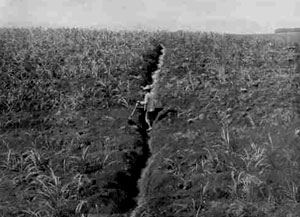|
|
|
|
 |
Sugar is a thirsty
crop. It takes one million gallons of water a day to
irrigate 100 acres of sugarcane. (Sugar Water) Modern
sugar planters knew that their success depended on moving water
from the streams to their fields. Once this water left the watershed,
it was never returned. How did the plantations alter traditional
water management practices? |
|
|
Plantation:
Water uses Sugar Water by Carol
Wilcox as a major source for pictures and text. Used with permission
of the author. |
|
|
|
|
|
|
|
|
|
Traditionally, the konohiki
allocated the water resource based on individual use and
maintenance. When disputes over water arose, it was the konohiki
who was responsible for their resolution.
(Sugar Water) |
|
|
|
|
|
|
|
 |
|
|
|
|
Limahuli kalo
|
|
|
|
|
|
|
|
|
|
|
|
|
|
After the mahele, water that had been used for the mutual
benefit of all became water used for private gain. To support
this new industry, the government allowed the sugar plantations
to take as much water as they desired from the streams. This
was in great contrast to the traditional practice of taking
no more than 50% of the stream's flow. Once water is diverted
into tunnels, it is not always possible to restore it to the
watershed where it came from. (Sugar Water) Photo
by D. Franzen |
|
|
|
|
|
|
The five streams of Nawiliwili were
all interrupted or diverted by reservoirs and ditches in their
upper reaches by the plantation. Pu'ali Stream was cut off historically
from its natural head waters. Now it is connected to reservoirs
on the east and west sides of Puhi. (Kido) |
|
|
|
| This change in water
use impacted those native planters who depended on a fair share
of the stream resource. New disputes over the water resource
ended up in the water commissions and courts. It is not surprising
that that there was little protest over this change in water
management. Hawaiians had lost their traditional culture, their
population was being wiped out by disease, and their land was
in the hands of foreign businessmen. (Sugar Water) Without
land, the water resource meant nothing. (Damon) |
 |
|
|
A diversion like this could easily
handle 50 million gallons a day. Photo by D. Franzen
(Sugar Water) |
|
 |
Traditionally, water rights went
with land use. From 1850 to 1973, the commissions and courts
consistently declared that surplus water went with the land,
allowing the plantations the right to divert water to wherever
they chose. (Sugar Water) |
|
| Many water diversions
were so remote that their existence and impact were not recognized.
(Sugar Water) Photo by D. Fleming |
|
|
|
|
|
Lihu'e Plantation built 51 miles of ditches with 18 intakes
from streams. Their system diverted an average of 100 - 140
million gallons a day. (Sugar Water) To the right,
William Harrison Rice built Lihu'e Plantation the first sugar
irrigation ditch in Hawai'i in 1856. |
 |
|
|
|
 |
George N. Wilcox began building a series of modest ditches for
Grove Farm in 1865. By the 1920's, Grove Farm had 16 miles of
ditches diverting 26 million gallons a day, some of it through
Ha'upu Ridge to Koloa Plantation - out of the watershed. (Sugar
Water) |
|
|
Grove Farm's Lower Ditch
Photo by D. Franzen (Sugar Water)
|
|
|
|
|
|
|
|
|
|
This flume carries water from Mt. Kahili into a tunnel through
Kilohana - final destination, Lihu'e.
Photo by Adam Asquith. |
|
|
|
|
|
|
|
|
|
|
 |
|
|
|
The same flume, from the inside.
Riding the water in these flumes was once a form of cheap entertainment.
Photo by Adam Asquith. |
|
|
|
|
|
|
Above, ditches for sugar water.
Map from Sugar Water |
|
|
|
|
|
| Another use for water
that Hawaiians never considered was hydropower. Plantations
built dams and used the flow to make electricity, run their
water pumps, and power their mills. To the right, a dam was
built on Nawiliwili Stream to create this pond to run the Lihu'e
Mill. In the 1940's, Grove Farm built a power plant on Papakolea
Stream. |
|
 |
|
|
|
|
Here's another angle on the Lihu'e
Mill Pond - courtesy of the Baker Collection, Kaua'i Historical
Society |
|
|
|
How did this new sugar water affect
the sustainability
of the ahupua'a at Nawiliwili Bay? |
|
|
|
|
|
|
|
|
|
|

